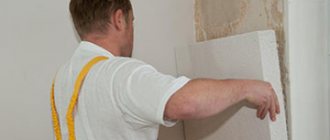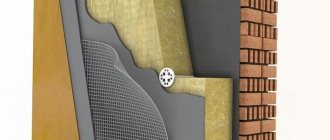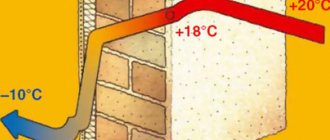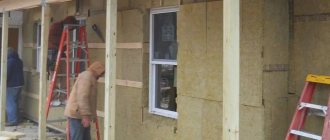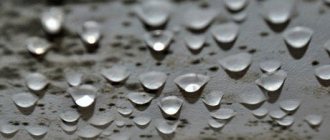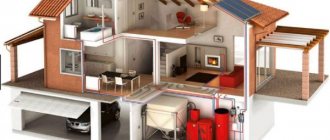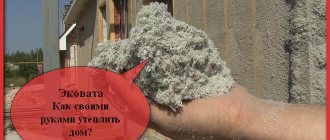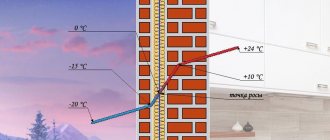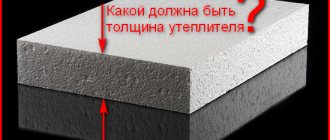One of the most important concepts in construction is dew point. At the stage of wall insulation, this allows you to correctly select the type and thickness of the heat-insulating material and create an optimal microclimate inside the building. There are several ways to determine the dew point. However, you also need to know what to do with the results obtained.
What is dew point
The dew point is a certain limit of air temperature, below which the vapor contained in the air becomes saturated and turns into liquid.
The dew point is the place where cold air meets warm air, and the place where their interaction forms liquid in the form of condensation. Using the example of building structures, the dew point appears in the form of condensation on the windows. Always, when it gets cold outside, we see fogging and water droplets forming on previously dry window panes. This is the closest and most harmless manifestation of the dew point.
condensation on the window
In nature, the dew point appears in the form of drops of morning dew on plant leaves and other objects. It is formed as a result of the interaction of cold night air and warm morning air heated by the sun's rays.
manifestation of dew point condensation in nature
In the case of heated premises, the dew point is created artificially at any time of the day, under conditions of temperature below zero outside.
It is a completely different matter if the formation of such dew point condensation is detected on the inside of the wall of the house. Even a not very experienced builder will be concerned about the formation of excess liquid in a previously dry room. Since the consequences of such accumulations of moisture can be the most unfavorable. But the interior wall of a house is not the only destructive place where incorrect calculation of the dew point or its absence can manifest itself.
Incorrect calculation and location of the dew point for a home is the number one destructive enemy in construction. Which, from the inside, slowly but surely destroys any strong structure.
Comfortable values for a person
For most people, conditions with a point value in the range of +10…+15℃ are optimal. If the indicator increases, then the person feels discomfort. When the point value is less than +10℃, the environment becomes dry, and from +15℃ humidity begins to be felt. If the indicator is above +20℃, it becomes stuffy. People with heart and respiratory problems are more susceptible to environmental parameters than others.
The dew point temperature determines the comfort level of living in the house
Where should the dew point be?
The ideal place for the dew point to occur in a wall is the insulation located on the outside of the wall. The thickness of the insulation on the wall should be such that in the coldest time condensation does not move into the wall itself, or if it does, it will not be for a long time.
dew point in insulation
For the destructive consequences of the dew point being in the body of a load-bearing wall, see the article below.
Walls based on porous materials, such as foam and gas blocks, shell rock and similar materials, require a larger layer of insulation, since they absorb and retain moisture well. That is, even a short-term (several days) presence of dew point in a porous wall can have a destructive effect on the internal integrity. Therefore, so-called warm materials for masonry walls can only be effective in certain regions, with not the most frosty winters.
If, according to calculations, the dew point will periodically move into the wall of the house itself or there is a high probability of such a shift, then this fact should be taken into account when choosing material for laying walls. For such cases, wall materials with high density are well suited and can withstand a large number of freezing and thawing cycles without damage. With a high frost resistance coefficient. Such frost-resistant materials include brick and expanded clay concrete.
frost resistance indicators of the most common wall materials
Thermal insulation material
To protect buildings from heat loss, high humidity and point shifts, it is insulated with thermal insulation materials. In winter, insulation helps reduce heating costs, and in summer it keeps the room cool. Each product has its own areas of application and properties. Eco-friendly and easy-to-install materials are used in construction. The required type of insulation is selected for certain conditions.
With proper insulation from the outside, the dew point will be located inside the insulation
According to their form, materials are divided into:
- roll;
- leafy;
- bulk;
- single.
By structure:
- fiber;
- cells;
- grainy.
Raw materials can be organic, inorganic and mixed.
Main characteristics of insulating materials:
- thermal conductivity;
- moisture absorption;
- porosity;
- humidity;
- density;
- vapor permeability;
- specific heat;
- strength, etc.
Penoplex
Penoplex is also called expanded polystyrene. Unlike foam polystyrene, the material has a higher density and is less subject to mechanical damage. It almost does not conduct steam due to its low vapor permeability coefficient. However, it belongs to group IV of flammability (it ignites quickly).
Penoplex is recommended for external wall insulation
Penoplex of the “comfort” category is produced for insulating walls, terraces, loggias, and balconies. Its thermal conductivity coefficient is 9 times less than that of mineral wool. The material requires little time to heat the room after cooling due to its low heat capacity. The operating temperature range is -70…+70℃. Penoplex of this type does not have the best sound insulation, has the lowest density and lower tensile strength compared to other materials.
Penoplex for walls is suitable only if an effective ventilation system is installed in the room to maintain comfortable humidity.
A 2 cm wide layer of polystyrene foam retains heat almost as well as 40 cm of mineral wool or 37 cm of brickwork.
Styrofoam
Polystyrene foam is a material characterized by lightness and buoyancy. It is resistant to fire, but when exposed to fire it begins to melt. The material is easy to process and is not subject to infection by fungi and mold.
Polystyrene foam is obtained from foamed polymer raw materials: polystyrene, polyethylene, polyvinyl chloride or polyurethane. It consists of small identical balls that are fastened together. High-density rigid foam is used for insulation. The panels are easy to connect using rubber or epoxy adhesive.
The temperature range is not important for polystyrene foam, but the material is subject to mechanical damage.
Slabs 5 and 10 cm thick are used as thermal insulation. But, despite the structure, the material is sound-permeable.
Polystyrene foam is one of the most common materials for home insulation.
Mineral wool
Thermal insulation material consists of compressed fibers. Glass, basalt and slag are used as raw materials. The starting material is melted and spun into fibers. Their length is 2-60 mm. The air pores of the mats fill approximately 95% of the total volume. The product is easy to produce and has a low cost.
Mineral wool has many qualities suitable for home insulation.
Due to its porosity, cotton wool allows air and steam to pass through, maintaining air exchange. At the same time, it does not burn and is resistant to moisture, has good sound insulation. But the material has 2 drawbacks:
- contains phenol;
- Flying pieces of cotton wool, falling on human skin, cause itching.
Dew point calculation online calculator
There are many online programs on the Internet - calculators, with which you can calculate the approximate location of the dew point in the wall. The program calculates the dew point based on a number of indicators that must be entered manually. This is information about the material from which it is planned to build the wall, the number of layers of the wall and their thickness, the air temperature inside and outside the building, air humidity. The online calculator is convenient for calculations. Together with digital calculations, you can see diagrams and graphs of the dew point movement depending on changes in air temperature. However, the calculation results for many calculators differ and how accurate the calculations are is unknown.
online calculator for determining dew point
Possible consequences
Improper installation of thermal insulation can lead to unpleasant consequences. The material is applied only to the facade, since additional insulation from the inside is considered impractical for the following reasons:
- Living space is decreasing.
- The wall freezes because the heat from the room does not reach the ceiling. As a result, condensation penetrates inside the thermal insulation. The wall is wet and subject to corrosion.
Poor installation results in wall destruction. If the surface under the insulation is uneven and old, it will have to be reapplied, after making repairs. If the insulation on the outside is not additionally covered, then in one season it will become wet, become unusable and begin to move away from the walls. The thermal layer must be protected from the external environment.
Video: Removing the dew point from the wall
Calculation of dew point using the device
The dew point can also be determined in real time using a special TV. This is an electronic device with a monitor that will display information about indoor humidity, air temperature and dew point. Such devices are relevant for measuring the dew point for an already erected and completed building structure. This device will not help in designing the thickness of walls and buildings.
dew point thermal imager
Experts' opinion
Experts believe that the best thermal insulation option is mineral wool. If installed correctly, the material will not cause harm and will last a long time. The main thing is to avoid high humidity. To do this, the cotton wool is additionally covered with a film that limits the access of moisture.
Another option is to install breathable materials on both sides of the insulation that will release liquid to the outside. It is recommended to lay polystyrene foam or expanded polystyrene in combination with materials that do not allow water vapor to pass through and prevent moisture condensation.
Damage to dew point for house walls
We figured out that the dew point can be located in three different parts of the wall:
- in external wall insulation
- in the wall, closer to the outside
- in the wall, closer to the inside
In each of the listed places, the dew point will manifest itself differently. If in one place it is harmless, then inside the house or in the wall it will have certain destructive consequences on the integrity of the wall. Below, we will analyze the behavior of the dew point in each of the listed places.
Dew point in external insulation
This is the most harmless dew point for your home. In this case:
- When the dew point occurs, condensation forms directly in the insulation itself.
- The insulation is not hygroscopic, therefore moisture is not retained in the wall structure and evaporates when the air temperature changes.
- Due to the vapor barrier properties of the insulation, the moisture that is formed when condensation evaporates goes outside and does not interact with the wall of the house.
- The walls of the house are dry throughout the year, both from the outside and from the inside
- The walls retain their strength and integrity for many decades
insulation on the outside
Dew point in the wall of the house, closer to the outside
- The behavior of a wall largely depends on the material from which it is made. Walls made of dense and heavy building materials such as brick, expanded clay concrete, stone, and wood can withstand dew point better. Because they are less susceptible to destruction and have a higher frost resistance coefficient.
- The walls of houses built from porous materials that absorb moisture well and allow steam to pass through. Such as foam blocks, gas blocks and similar materials, the effect of the dew point should be minimally short.
destruction of a wall due to moisture
- When condensation occurs inside the wall, the wall material becomes saturated with liquid. When the air temperature subsequently drops below zero, the accumulated liquid freezes and increases in volume. An increase in the volume of liquid destroys any wall material from the inside. This leads to the formation of both small and large cracks in the wall structure. The walls crumble and finally lose their strength.
- If the wall, in which the dew point is inside and is insulated from the outside, then the insulation will not prevent the accumulated moisture from escaping outside. Therefore, all the liquid will accumulate on the surface, between the insulation and the wall. This entails the formation of mold and mildew, with all the ensuing consequences that are harmful both to the building and to human health.
- If the wall of the house is not insulated from the outside, then the liquid will come out as the air temperature rises, but this will not protect the wall from internal destruction after the water freezes. We can observe similar evaporation of liquid from a damp wall in the form of a white coating on brick walls.
release of moisture from a brick wall in the form of a white coating
Dew point in the wall of the house, closer to the inner surface
It occurs when steam passes through the middle of the wall thickness and condensation begins to form closer to the surface of the wall, which is located inside the house.
Consequences of dew point for the interior decoration of the house:
- The masonry, saturated with moisture, begins to release liquid in the form of water droplets on the inner wall and into the house.
- A wet wall surface destroys the interior decoration of the room: putty, wallpaper and other finishing materials.
- Mold and mildew form on the walls and in the corners, which will be very difficult to get rid of.
- An unpleasant, shabby smell of decomposition appears in the house, which is harmful to health.
- The overall heat temperature in the house decreases.
mold on the wall inside the house
The most destructive and harmful consequences for the house is when the dew point is closer to the inner surface of the wall.
Dew point is an important parameter that should be taken into account when designing and constructing walls, roofs and the construction of the entire house. Failure to comply with it can lead to irreversible and critical consequences for the entire building.
Areas of application
There are many areas that take this temperature into account. One of the areas is aviation. During aircraft operation, condensation may form on some of its parts and freeze. This leads to freezing of the engine, metal structures of the flying vehicle and its breakdown.
In forestry, fire conservationists use dew point to calculate fire hazard class.
Experts calculate the likelihood of forest fires and develop protective measures.
Most often, determining the point is necessary in construction and agriculture.
Video: Dew point - insulating the house wisely
Construction
In construction, this value is determined when insulating the facades of buildings and private buildings. If you do not take into account the indicator or calculate it incorrectly, due to settling moisture, the wall finishing material will deteriorate or pathogenic flora and mold will appear.
Agriculture
In agriculture, experts determine the likelihood of damage to crops due to weather conditions, knowing the point and atmospheric humidity.
When cultivating new plants, breeders try to create varieties that condense moisture on the vegetative parts. Such plantings can exist with little precipitation.
Temper-3D
The English term for Dew Point is Dew point.
If the surface is colder or equal to the dew point, then condensation will fall on it
The lower the humidity, the lower the dew point is than the actual temperature. The higher the humidity, the higher the dew point and the closer to the actual temperature. If the relative humidity is 100%, then the dew point is the same as the actual temperature.
For example, in a bathroom, if the shower is turned on (humidity is close to 100%), the mirror always “fogs up”, and vice versa, if the humidity is zero, then condensation will never fall out (in a sealed double-glazed window the humidity is close to 0%, a special an adsorbent that absorbs moisture, so during any cooling, it will never “fog up” from the inside).
If the glass unit fogs up from the inside, it means it is not sealed and the adsorbent can no longer absorb all the moisture.
Table for determining dew point
As can be seen from the table, the dew point depends on temperature and humidity.
The left column shows the temperature and the top column shows the humidity.
For example, at a temperature of 20 °C and a humidity of 55% (sanitary standards for residential premises), the dew point is 10.69 °C. If the temperature in the apartment, for example in a corner, is below 10.69 °C, then the corner will “fog up”. Humidity is 55%, this is a fairly dry room (in reality, in a living room, especially in the kitchen, the humidity is 60%-70%, or more, i.e. the wall will “leak” (the wallpaper will peel off) at a higher temperature).
Dew point temperatures, for different temperatures and relative humidity in the room:
| % humidity / temperature °C | 40% | 45% | 50% | 55% | 60% | 65% | 70% | 75% | 80% | 85% | 90% | 95% |
| -5 | -15,3 | -14,04 | -12,9 | -11,84 | -10,83 | -9,96 | -9,11 | -8,31 | -7,62 | -6,89 | -6,24 | -5,6 |
| -4 | -14,4 | -13,1 | -11,93 | -10,84 | -9,89 | -8,99 | -8,11 | -7,34 | -6,62 | -5,89 | -5,24 | -4,6 |
| -3 | -13,42 | -12,16 | -10,98 | -9,91 | -8,95 | -7,99 | -7,16 | -6,37 | -5,62 | -4,9 | -4,24 | -3,6 |
| -2 | -12,58 | -11,22 | -10,04 | -8,98 | -7,95 | -7,04 | -6,21 | -5,4 | -4,62 | -3,9 | -3,34 | -2,6 |
| -1 | -11,61 | -10,28 | -9,1 | -7,98 | -7,0 | -6,09 | -5,21 | -4,43 | -3,66 | -2,94 | -2,34 | -1,6 |
| -10,65 | -9,34 | -8,16 | -7,05 | -6,06 | -5,14 | -4,26 | -3,46 | -2,7 | -1,96 | -1,34 | -0,62 | |
| 1 | -9,85 | -8,52 | -7,32 | -6,22 | -5,21 | -4,26 | -3,4 | -2,58 | -1,82 | -1,08 | -0,41 | 0,31 |
| 2 | -9,07 | -7,72 | -6,52 | -5,39 | -4,38 | -3,44 | -2,56 | -1,74 | -0,97 | -0,24 | 0,52 | 1,29 |
| 3 | -8,22 | -6,88 | -5,66 | -4,53 | -3,52 | -2,57 | -1,69 | -0,88 | -0,08 | 0,74 | 1,52 | 2,29 |
| 4 | -7,45 | -6,07 | -4,84 | -3,74 | -2,7 | -1,75 | -0,87 | -0,01 | 0,87 | 1,72 | 2,5 | 3,26 |
| 5 | -6,66 | -5,26 | -4,03 | -2,91 | -1,87 | -0,92 | -0,01 | 0,94 | 1,83 | 2,68 | 3,49 | 4,26 |
| 6 | -5,81 | -4,45 | -3,22 | -2,08 | -1,04 | -0,08 | 0,94 | 1,89 | 2,8 | 3,68 | 4,48 | 5,25 |
| 7 | -5,01 | -3,64 | -2,39 | -1,25 | -0,21 | 0,87 | 1,9 | 2,85 | 3,77 | 4,66 | 5,47 | 6,25 |
| 8 | -4,21 | -2,83 | -1,56 | -0,42 | -0,72 | 1,82 | 2,86 | 3,85 | 4,77 | 5,64 | 6,46 | 7,24 |
| 9 | -3,41 | -2,02 | -0,78 | 0,46 | 1,66 | 2,77 | 3,82 | 4,81 | 5,74 | 6,62 | 7,45 | 8,24 |
| 10 | -2,62 | -1,22 | 0,08 | 1,39 | 2,6 | 3,72 | 4,78 | 5,77 | 7,71 | 7,6 | 8,44 | 9,23 |
| 11 | -1,83 | -0,42 | 0,98 | 1,32 | 3,54 | 4,68 | 5,74 | 6,74 | 7,68 | 8,58 | 9,43 | 10,23 |
| 12 | -1,04 | 0,44 | 1,9 | 3,25 | 4,48 | 5,63 | 6,7 | 7,71 | 8,65 | 9,56 | 10,42 | 11,22 |
| 13 | -0,25 | 1,35 | 2,82 | 4,18 | 5,42 | 6,58 | 7,66 | 8,68 | 9,62 | 10,54 | 11,41 | 12,21 |
| 14 | 0,63 | 2,26 | 3,76 | 5,11 | 6,36 | 7,53 | 8,62 | 9,64 | 10,59 | 11,52 | 12,4 | 13,21 |
| 15 | 1,51 | 3,17 | 4,68 | 6,04 | 7,3 | 8,48 | 9,58 | 10,6 | 11,59 | 12,5 | 13,38 | 14,21 |
| 16 | 2,41 | 4,08 | 5,6 | 6,97 | 8,24 | 9,43 | 10,54 | 11,57 | 12,56 | 13,48 | 14,36 | 15,2 |
| 17 | 3,31 | 4,99 | 6,52 | 7,9 | 9,18 | 10,37 | 11,5 | 12,54 | 13,53 | 14,46 | 15,36 | 16,19 |
| 18 | 4,2 | 5,9 | 7,44 | 8,83 | 10,12 | 11,32 | 12,46 | 13,51 | 14,5 | 15,44 | 16,34 | 17,19 |
| 19 | 5,09 | 6,81 | 8,36 | 9,76 | 11,06 | 12,27 | 13,42 | 14,48 | 15,47 | 16,42 | 17,32 | 18,19 |
| 20 | 6,0 | 7,72 | 9,28 | 10,69 | 12,0 | 13,22 | 14,38 | 15,44 | 16,44 | 17,4 | 18,32 | 19,18 |
| 21 | 6,9 | 8,62 | 10,2 | 11,62 | 12,94 | 14,17 | 15,33 | 16,4 | 17,41 | 18,38 | 19,3 | 20,18 |
| 22 | 7,69 | 9,52 | 11,12 | 12,56 | 13,88 | 15,12 | 16,28 | 17,37 | 18,38 | 19,36 | 20,3 | 21,6 |
| 23 | 8,68 | 10,43 | 12,03 | 13,48 | 14,82 | 16,07 | 17,23 | 18,34 | 19,38 | 20,34 | 21,28 | 22,15 |
| 24 | 9,57 | 11,34 | 12,94 | 14,41 | 15,76 | 17,02 | 18,19 | 19,3 | 20,35 | 21,32 | 22,26 | 23,15 |
| 25 | 10,46 | 12,75 | 13,86 | 15,34 | 16,7 | 17,97 | 19,15 | 20,26 | 21,32 | 22,3 | 23,24 | 24,14 |
| 26 | 11,35 | 13,15 | 14,78 | 16,27 | 17,64 | 18,95 | 20,11 | 21,22 | 22,29 | 23,28 | 24,22 | 25,14 |
| 27 | 12,24 | 14,05 | 15,7 | 17,19 | 18,57 | 19,87 | 21,06 | 22,18 | 23,26 | 24,26 | 25,22 | 26,13 |
| 28 | 13,13 | 14,95 | 16,61 | 18,11 | 19,5 | 20,81 | 22,01 | 23,14 | 24,23 | 25,24 | 26,2 | 27,12 |
| 29 | 14,02 | 15,86 | 17,52 | 19,04 | 20,44 | 21,75 | 22,96 | 24,11 | 25,2 | 26,22 | 27,2 | 28,12 |
| 30 | 14,92 | 16,77 | 18,44 | 19,97 | 21,38 | 22,69 | 23,92 | 25,08 | 26,17 | 27,2 | 28,18 | 29,11 |
| 31 | 15,82 | 17,68 | 19,36 | 20,9 | 22,32 | 23,64 | 24,88 | 26,04 | 27,14 | 28,08 | 29,16 | 30,1 |
| 32 | 16,71 | 18,58 | 20,27 | 21,83 | 23,26 | 24,59 | 25,83 | 27,0 | 28,11 | 29,16 | 30,16 | 31,19 |
| 33 | 17,6 | 19,48 | 21,18 | 22,76 | 24,2 | 25,54 | 26,78 | 27,97 | 29,08 | 30,14 | 31,14 | 32,19 |
| 34 | 18,49 | 20,38 | 22,1 | 23,68 | 25,14 | 26,49 | 27,74 | 28,94 | 30,05 | 31,12 | 32,12 | 33,08 |
| 35 | 19,38 | 21,28 | 23,02 | 24,6 | 26,08 | 27,64 | 28,7 | 29,91 | 31,02 | 32,1 | 33,12 | 34,08 |
| % humidity / temperature °C | 40% | 45% | 50% | 55% | 60% | 65% | 70% | 75% | 80% | 85% | 90% | 95% |
Original document: SP 23-101-2004, Group Zh24, OKS 91.120.01, Date of introduction 2004-06-01, APPENDIX R (reference)
Main heat losses
First, a piece of advice: when insulating a house, you should not strictly adhere to the standards prescribed in SNiP 02/23/2003 “Thermal protection of buildings”! They are much softer than European insulation standards and are designed for cheap energy. Tighten the Russian standard, insulate the house with high quality, modern materials.
But even in this case, heat loss is possible. To make sure of this, just rent a thermal imager and conduct an examination.
Now let's look at the possible causes of heat loss:
Steel door. An extensive bridge, a whole bridge of cold, which will not allow you to effectively heat not only the hallway, but the entire house. A metal entrance door that is too thin and not insulated can become a problem. We have already told you what to do in this case. The most effective way to deal with heat loss through the front door is a vestibule or installing a second door;
The second cause of heat loss is windows. A two-chamber modern double-glazed window has a heat transfer resistance of only 0.57 (m²×°C)/W. This is two times less than that of a high-quality polystyrene foam insulated wall. You can combat this by installing heated glass, using thermal film, or installing a Scandinavian window, where a double-glazed window complements single glazing in a separate frame. Even warm, thick curtains will help reduce heat loss through the windows;
Also, the reason that heat leaves the house can be defects made during the installation of windows and doors. For example, polyurethane foam, which was used to seal the joints of a door or window with a wall, remained uncovered for a long time. It begins to literally crumble under the sun's rays, and cracks appear. Or the foam was originally poured poorly, leaving gaps. If such heat losses have been identified, you will have to solve problems and redo the work. Immediately order warm installation of windows and doors using a three-layer installation seam;
The fourth reason for heat loss can be cold bridges that occur on the lower rims of the frame and frame, at the junction of the basement, external walls and ceilings of the first floor
These are problem areas, the insulation of which requires special attention. Sealing cracks, insulating the base with expanded polystyrene, and caulking logs will help cope with heat loss; The fifth reason concerns frame houses
The fifth reason concerns frame houses
They may experience heat loss as a result of the fact that the insulation under the siding simply slipped because it was incorrectly and unreliably fastened. In addition, rodents could have appeared between the walls and built a nest in the mineral wool or chewed through the polystyrene foam. There is only one way out - to sort out the casing and change the insulation. In order not to dismantle the entire wall, we again recommend using a thermal imager to identify the problem area;
The sixth reason for heat loss is often problems with roof insulation. It is here that it is most difficult not to miss a single section, there are many hard-to-reach corners. You need to work under the ridge, everywhere, so that the insulation is laid thoroughly, without gaps. As you remember, warm air rises, so through the under-roof space you can lose the most heat. What to do? Look for problem areas, if necessary, change the insulation that has become wet, blow out and seal the cracks, getting rid of cold bridges.
These are the main reasons why your home may be losing heat. It is possible and necessary to fight them, so as not to heat the street, but to provide comfort to all households with minimal heating costs. Published by econet.ru
If you have any questions on this topic, ask them to the experts and readers of our project here.
Physics of steam condensation
Water is present in the environment of our home in two states of aggregation:
- liquid – this is water for cooking and sanitary needs;
- gaseous - steam over boiling water or as one of the fractions of exhaled air.
In addition to such obvious places, traces of moisture are necessarily present in the materials of the elements of the building's building structure: concrete or brick walls, ceilings, and the base of the floor. There are no ideally dry building materials in nature. In stable warm weather, the steam present in the air and the moisture in the walls of the home are in thermal equilibrium.
In this case, the partial pressure of steam in the air from the street (outer side of the wall) and inside the house (inner side of the wall) is the same. This means that no movement of water vapor occurs through the wall. In frosty weather, the humidity of cold air is low, and the partial pressure of vapor in such air is low. In accordance with the laws of thermophysics, high-pressure steam (living space) begins to diffuse through the wall material to the cold street, where the pressure is lower.
When passing through the dew point in the wall, the steam turns into a liquid aggregate state, forming condensate moisture.
The appearance of moisture in the wall structure is accompanied by a number of negative factors:
- The thermal conductivity of a damp wall increases several times. This will mean that the heat exchange between the heated room and the street will intensify, and the house will always be cold.
- During the cold season, periodic freezing of condensate moisture in the wall occurs, followed by thawing. The cyclical nature of freezing has a destructive effect on the structure of the building material, reducing the period of trouble-free operation of the building.
The figure below schematically shows the transformation of vaporous moisture into a liquid state (blue color is used) when TR gets inside the wall of the home.
Moisture condensation when the TR is located inside the wall of the home
Methods of insulation from the inside
When choosing a material for insulation, you must consider the following characteristics:
- moisture resistance;
- environmental Safety;
- fire safety.
The thickness of the thermal insulation layer must be sufficient to maintain the dew point in the insulation. Thermal calculation of dew point in the Russian Federation is carried out in accordance with established requirements.
Step-by-step steps for the adhesive insulation method:
- You need to start by removing the old layer of finishing.
- Then you need to level the surface of the wall.
- The next step is primer. It is necessary for better adhesion between the wall and the finishing material.
- Re-leveling the wall. Plastering.
- Bonding thermal insulation material. To do this, you will need glue used for working with ceramic tiles. First it is applied along the perimeter of the slab, and then in the center. The entire layer is evenly distributed using a notched trowel. The sheet is applied to the wall, and excess glue is removed. You need to start gluing from the corner from the bottom up.
- Drying. After finishing the gluing process, the wall should be allowed to dry for three days.
- Fastening the insulation. When everything is ready, you need to secure the material with dowels.
Tips for adjusting the dew point when installing metal-plastic windows
The formation of a point is influenced by three main factors:
- Atmosphere pressure;
- temperature;
- humidity.
The cooler the room, the less moisture is needed to transform it into a liquid state.
To avoid the formation of condensation on the windows, the room itself should be warm and relatively dry. In this case, the window itself must be installed in the so-called “warm zone”.
To ensure comfortable conditions, you should take into account the advice of professionals:
Poor ventilation increases air humidity
Therefore, it is necessary to promptly clean the air ducts and ventilate the room. To prevent cold air from entering the room, it is recommended to insulate the walls and slopes. On the first and last floors, it is important to take care of the thermal insulation of the ceilings and floors. These measures will help eliminate high humidity. Cheap, low-quality window options can cause additional problems due to the profile features.
Preventive measures will help you save money and ensure complete comfort.
